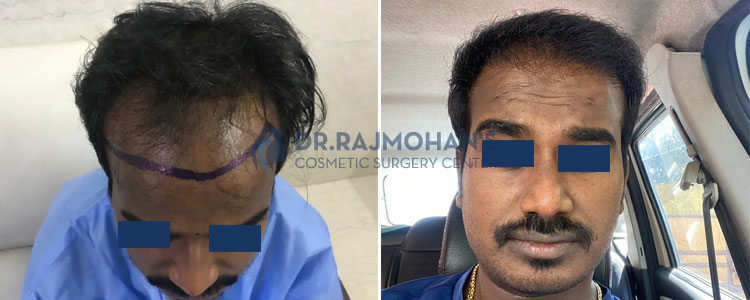- Call: 9940436649 / 9791112455
- Email us: admin@drrajmohan.com
Hair transplant
Hair transplant
Baldness
Hair is considered an essential part of overall identity: especially for women, for whom it often represents femininity and attractiveness. Men typically associate a full head of hair with youth and vigor.
Male pattern baldness is characterized by hair receding from the lateral sides of the forehead (receding hairline) and/or a thinning crown balding to the area known as the ‘vertex’. Both become more pronounced until they eventually meet, leaving a horseshoe-shaped ring of hair around the back of the head. Approximately 25 percent of men begin balding by age 30; two-thirds begin balding by age 60.
There is a 4 in 7 chance of receiving the baldness gene Onset of hair loss sometimes begins as early as the end of puberty, and is mostly genetically determined. It was previously believed that baldness was inherited from the maternal grandfather. While there is some basis for this belief, both parents contribute to their offspring’s likelihood of hair loss. Although baldness is not as common in women as in men, the psychological effects of hair loss tend to be much greater. Typically the frontal hairline is preserved but the density of hair is decreased on all areas of the scalp.
Hair thinning and baldness causes stress for sufferers, a fact which can be attributed to the psychology of appearance. People experiencing hair thinning often find themselves in a situation where their physical appearance is at odds with their own self-image, and commonly worry that they appear older than they are or less attractive to others. Psychological problems due to baldness, if present, are typically most severe at the onset of symptoms.
Hair transplantation is a surgical technique that involves moving individual hair follicles from one part of the body (the donor site) to bald or balding parts (the recipient site). It is primarily used to treat male pattern baldness. It this case, grafts containing hair follicles that are genetically resistant to balding are transplanted to bald scalp. Likewise, it is also used to restore eyelashes, eyebrows, beard hair, chest hair, and pubic hair and to fill in scars caused by accidents or surgery such as face-lifts and previous hair transplants. Since hair naturally grows in follicles that contain groupings of 1 to 4 hairs, today’s most advanced techniques transplant these naturally occurring 1–4 hair “follicular units” in their natural groupings. Thus modern hair transplantation can achieve a natural appearance by mimicking nature hair for hair. This hair transplant procedure is called Follicular Unit Transplantation (FUT). Donor hair can be harvested in two very different ways;
Strip Harvesting
A strip of scalp is removed under local anesthesia, the wound is then sutured back together and this piece of scalp tissue is then cut in to small pieces of tissue called grafts which are then transplanted back in to the thinning area of the patient’s head. This method will leave a linear scar in the donor area, which should be covered by a patient’s hair (if long). The recovery period is around 2 weeks and will require the stitches to be removed by doctor.
Follicular Unit Extraction or FUE Harvesting
Individual follicles of hair are removed under local anesthesia; this micro removal uses tiny punches of between 0.6mm and 1.25mm in diameter. Each follicle is then reinserted back in to the scalp in the thinning area using a micro blade. Because individual follicles are removed, only small, punctate scars remain and any post-surgical pain is minimized. As no suture removal is required, recovery from FUE is within 7 days.
Surgery
Transplant operations are performed on an outpatient basis, with mild sedation (optional) and injected local anesthesia, which typically last about six hours. The scalp is shampooed and then treated with an antibacterial agent prior to the donor scalp being harvested.
In the usual follicular unit procedure, the surgeon harvests a strip of skin from the posterior scalp, in an area of good hair growth. The excised strip is about 1–1.5 inches x 15–30 cm in size. While closing the resulting wound, team of trained assistants begin to dissect individual follicular unit grafts from the strip. Working with binocular Stereo-microscopes and high power loupes , they carefully remove excess fibrous and fatty tissue while trying to avoid damage to the follicular cells that will be used for grafting. FUE harvesting negates the need for large areas of scalp tissue to be harvested and can give very natural results with little or no scarring.
The surgeon then uses very small needles needles to puncture the sites for receiving the grafts, placing them in a predetermined density and pattern, and angling the wounds in a consistent fashion to promote a realistic hair pattern.




